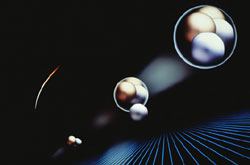Roles for reactive iodine and nitrogen species
Reactive halogen compounds play major roles in the photochemical processing of air in the marine boundary layer. In particular, these species may catalytically destroy tropospheric ozone, influence the oxidation potential, and perhaps the particle formation. Understanding the role of chemical trace species in atmospheric chemistry is thus critical for establishing their effects on climate forcing through their radiative properties and troposphere's ability to cleanse itself of harmful pollutants. Within the scope of the THALOZ project, comprehensive observations and numerical experimentations were coordinated to reveal the importance and interrelationship of small-scale processes driving chemistry in near-surface marine atmosphere. Chemical reactions involving halogen radicals can be initiated by various mechanisms including release of halides from sea salt, like aerosols. An existing atmospheric chemical model was used to aid the calculation of the expected release of chlorine atoms in the near-surface marine atmosphere. This was extended to include heterogeneous chemical reactions occurring on sea-salt particles known as aerosols and resulting from two activation mechanisms, iodine and nitrogen-mediated. By means of extensive numerical simulations, it was shown that the uptake of both hypoiodous acid (HOI) and nitrate (N2O5) radicals can liberate chlorine atoms from sea-salt aerosol at significant rate. A characteristic pulse in the chlorine atoms production after sunrise was predicted, which led to a steady production of several thousands of molecules per cubic centimetre during the day. Magnitudes of chlorine atoms concentrations in the context of these processes could provide an alternative diagnostic basis for future field experiments. Further details can be found in the relevant publication of the results in the Journal of Geophysical Reseach.







